Mega-Powerful Nitrate and Phosphate Remover Replaces Skimmer, Refugium, Everything
- Thread starter santamonica
- Start date
santamonica
Member
Well I have no nuisance algae, and I'm feeding more than 10 ml of phyto/roti/pods per day, so it's working pretty good. 
If you light only one side, be sure to double the screen size, and double the lighting on that one side.
If you light only one side, be sure to double the screen size, and double the lighting on that one side.
santamonica
Member
No, "plastic canvas" is overall, the best.
santamonica
Member
Successes of the Day:
Marine_Nick on the RP site: "Thought I'd update on my screen. When setting it up I was concerned about light pollution from the sump into the room, and noise from the falling water. as my tank is on an outside wall, I wanted to put the screen outside if possible. I already had an old 18 x 12 x 12 tank, so had it drilled and put a small wier in it, the water is pumped from the sump up and out through the wall to the screen, runs down the screen, through the weir, back through the wall and back into the sump. All of this is in a small shed I made which contains all the lighting etc, my screen is 18 inches tall by 12 inches wide and has a light on either side. Screen has been running now for 4 weeks, and my nitrates have dropped from 30 to 7 and phosphate from 0.25 to 0. In the last 4 weeks, nothing else has changed in my tank other than more fish being introduced, and therefore more food being added, and still the parameters have dropped!! Overall I'm really happy with results so far and hope to see the nitrates drop to zero in the next week or two. Big thanks to Santa Monica for this thread and all the info!"
jtrembley on the MD site: "I got frustrated with the skimmer (EuroReef, rated for 80) on my 40 gallon a while back. It was pulling out *lots* of crud, but I was having trouble with detritus building up, and rising P values. Since yanking the skimmer and DIYing (poorly) a rev. 2 scrubber [acrylic box style], phosphates and nuisance algae are down, and the backlog of detritus is slowly being consumed. I'm seeing lots more worms (particularly the small ones that build white, spiraling tubes) and 'pods (amphi- and cope- that is, but not octo-). Here's the funny thing: at the 3 year stage of my 40, I started getting lots of nuisance algae, despite having one of the hands-down best skimmers for small tanks, an MCE600, on it. Thinking that I was doing something wrong, I put an MC-80 on it. After another year, I started getting more and more detritus building up in the display, despite having a *lot* (over 2k GPH) of flow. And then I noticed something else: I no longer had many fan and bristle worms, amphipods, or copepods left in the sytem, either. So...I started swapping out my old LR for new, to replenish the critters. And I tried Fauna Marin and vodka dosing. But the critters weren't really spreading, and the nuisance algae was getting worse, and my P was rising despite water changes. So, I thought about it, poked around, and looked at Eric Borneman's study of *fresh* skimmate (i.e., not stuff that was left in the cup to rot). And I realized something: having a high quality skimmer on the tank was probably stripping the tank of big chunks of its potential cleanup crew. So I took off the skimmer, and put in a turf screen to cover the water's surface in what used to be the skimmer's chamber in my sump. Low and behold: I'm feeding more; I'm once again seeing fresh worm tracks in my sand bed; the copepods are back; the nuisance algae is dying off; P is undetectable by hobby kits; and the detritus is slowly clearing up. And I'm not doing as many water changes. I checked pH this morning, it was 8.2, before the lights are on. I'm honestly not seeing the down side. So yeah, removing the skimmer and putting in a $5 turf scrubber fixed my tank of "old tank syndrome". Just for giggles, I just tested my N (0.2 or 0.5 Salifert) and P (0.05 Hanna photometer). No visible HA, turfs, or cyano in the display, and I can (easily) feed 2X cubes of Hikari mysis, some dulse, and 2 scoops' worth of Reef Chili daily (again, in a 40). And I haven't done a water change in a month. I'm honestly not seeing a downside to scrubbers at this point."
Marine_Nick on the RP site: "Thought I'd update on my screen. When setting it up I was concerned about light pollution from the sump into the room, and noise from the falling water. as my tank is on an outside wall, I wanted to put the screen outside if possible. I already had an old 18 x 12 x 12 tank, so had it drilled and put a small wier in it, the water is pumped from the sump up and out through the wall to the screen, runs down the screen, through the weir, back through the wall and back into the sump. All of this is in a small shed I made which contains all the lighting etc, my screen is 18 inches tall by 12 inches wide and has a light on either side. Screen has been running now for 4 weeks, and my nitrates have dropped from 30 to 7 and phosphate from 0.25 to 0. In the last 4 weeks, nothing else has changed in my tank other than more fish being introduced, and therefore more food being added, and still the parameters have dropped!! Overall I'm really happy with results so far and hope to see the nitrates drop to zero in the next week or two. Big thanks to Santa Monica for this thread and all the info!"
jtrembley on the MD site: "I got frustrated with the skimmer (EuroReef, rated for 80) on my 40 gallon a while back. It was pulling out *lots* of crud, but I was having trouble with detritus building up, and rising P values. Since yanking the skimmer and DIYing (poorly) a rev. 2 scrubber [acrylic box style], phosphates and nuisance algae are down, and the backlog of detritus is slowly being consumed. I'm seeing lots more worms (particularly the small ones that build white, spiraling tubes) and 'pods (amphi- and cope- that is, but not octo-). Here's the funny thing: at the 3 year stage of my 40, I started getting lots of nuisance algae, despite having one of the hands-down best skimmers for small tanks, an MCE600, on it. Thinking that I was doing something wrong, I put an MC-80 on it. After another year, I started getting more and more detritus building up in the display, despite having a *lot* (over 2k GPH) of flow. And then I noticed something else: I no longer had many fan and bristle worms, amphipods, or copepods left in the sytem, either. So...I started swapping out my old LR for new, to replenish the critters. And I tried Fauna Marin and vodka dosing. But the critters weren't really spreading, and the nuisance algae was getting worse, and my P was rising despite water changes. So, I thought about it, poked around, and looked at Eric Borneman's study of *fresh* skimmate (i.e., not stuff that was left in the cup to rot). And I realized something: having a high quality skimmer on the tank was probably stripping the tank of big chunks of its potential cleanup crew. So I took off the skimmer, and put in a turf screen to cover the water's surface in what used to be the skimmer's chamber in my sump. Low and behold: I'm feeding more; I'm once again seeing fresh worm tracks in my sand bed; the copepods are back; the nuisance algae is dying off; P is undetectable by hobby kits; and the detritus is slowly clearing up. And I'm not doing as many water changes. I checked pH this morning, it was 8.2, before the lights are on. I'm honestly not seeing the down side. So yeah, removing the skimmer and putting in a $5 turf scrubber fixed my tank of "old tank syndrome". Just for giggles, I just tested my N (0.2 or 0.5 Salifert) and P (0.05 Hanna photometer). No visible HA, turfs, or cyano in the display, and I can (easily) feed 2X cubes of Hikari mysis, some dulse, and 2 scoops' worth of Reef Chili daily (again, in a 40). And I haven't done a water change in a month. I'm honestly not seeing a downside to scrubbers at this point."
sly
Active Member
Overall I'm happy with my scrubber... When I started my nitrates were around 80ppm (after checking with a new salifert test kit, my old one was bad) and phosphates were off the chart above 10ppm... It's hard to say exactly how high they were because that's where the scale stopped.
Last week I checked and my nitrates are down to 20ppm and the phosphates are 2 ppm... maybe 1. I have done no water changes and minimal maintenance. I get a very good mat of healthy green algae once every week or so. I'll upload some more pics of my latest harvest later.
I seem to have hit a roadblock though. I still don't want to break down and do a water change because I want to see if this will work on its own. I have a bit of sludge at the bottom of my sump that needs to be removed and I probably need to try vacuuming the substrate to see if it has any welled up inside. For now my nitrate doesn't seem to want to go any lower than this... but it's not rising either...
I did make a few changes to my tank. I removed the sponge pre-filter from the wet/dry and removed the bio-balls. Then I added a pumice like rock that is supposed to be much more efficient than bio-balls. I also added some live sand to my refugium so now it's about 4-5 inches deep. I did all this about 2 months ago...
Now maybe I just need to clean the tank and see what happens... but so far I am impressed with the scrubber. I guess one drawback is that it does require some maintenance... If you don't keep an eye on it, it can clog over time if you have a lot of growth. About 2 weeks is all I can go without cleaning mine.
Last week I checked and my nitrates are down to 20ppm and the phosphates are 2 ppm... maybe 1. I have done no water changes and minimal maintenance. I get a very good mat of healthy green algae once every week or so. I'll upload some more pics of my latest harvest later.
I seem to have hit a roadblock though. I still don't want to break down and do a water change because I want to see if this will work on its own. I have a bit of sludge at the bottom of my sump that needs to be removed and I probably need to try vacuuming the substrate to see if it has any welled up inside. For now my nitrate doesn't seem to want to go any lower than this... but it's not rising either...
I did make a few changes to my tank. I removed the sponge pre-filter from the wet/dry and removed the bio-balls. Then I added a pumice like rock that is supposed to be much more efficient than bio-balls. I also added some live sand to my refugium so now it's about 4-5 inches deep. I did all this about 2 months ago...
Now maybe I just need to clean the tank and see what happens... but so far I am impressed with the scrubber. I guess one drawback is that it does require some maintenance... If you don't keep an eye on it, it can clog over time if you have a lot of growth. About 2 weeks is all I can go without cleaning mine.
santamonica
Member
With phosphate that high, my quick answer would be that you need to clean more often, or get a bigger scrubber. Remember that when algae gets as thick as yours does, the underlying layers are dying from lack of light, and releasing N and P back into the water. So the outside layers are busy filtering what is given off by the inside layers, and thus there's not enough to filter the tank. Cleaning twice a week would stop this.
That's why sizing is important. Too small, and this happens. I say just turn off the surge for now, add an extra cleaning per week, and see what happens. That will definately improve things. If not enough, then consider enlarging.
That's why sizing is important. Too small, and this happens. I say just turn off the surge for now, add an extra cleaning per week, and see what happens. That will definately improve things. If not enough, then consider enlarging.
santamonica
Member
.
Update: The Trick of Dark Brown Algae
This has now happened to many people who have new scrubbers. They get early growth, but it's not the green stuff that they see in most pics. Instead it's a dark brown super-thick "coating", or a black "tar", that looks like it was poured on:
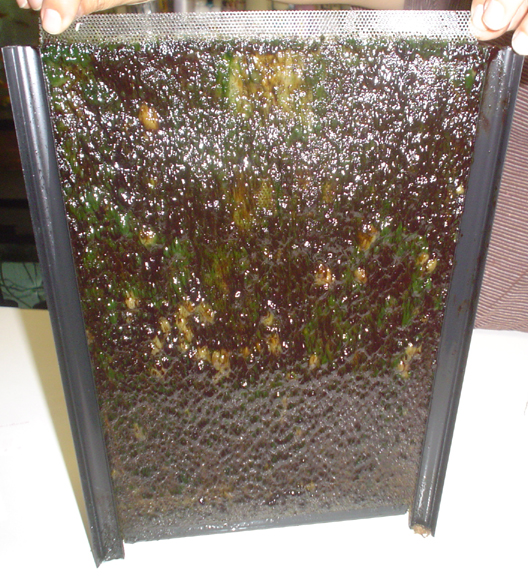
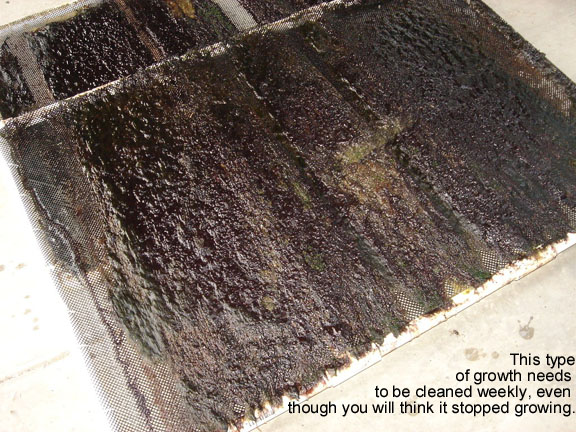
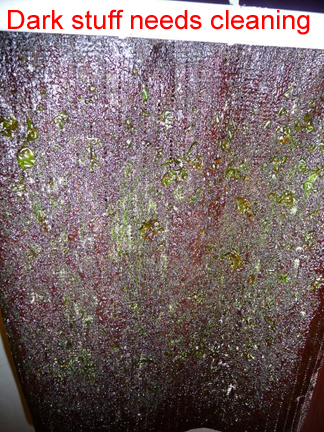
What you have here is the type of algae that grows when nutrients are extremely high (!). After a few cleanings, when the nutirents come down, the color will lighten up to some balance point where it will stay. The big problem, however, is that people think the screen is not growing, so they leave it in to "grow more" (by not cleaning it). BIG MISTAKE! This type of algae does not grow thick, at all. It never gets more than 1/4" (6mm) or so. And worse, since it's SO DARK, it block all light from reaching the bottom layers, thus causing those layers to die and release nitrate and phosphate back into the water. So the solution is to clean ANY and ALL dark brown/black algae right away, and don't even wait until the end of the week. Basically, if you cannot see your screen, then light is not reaching it and it needs to be cleaned. You'll only have to do this a few times before the nutrients come down and the algae color lightens up. Don't fall for the Dark Brown Algae Trick.
Update: The Trick of Dark Brown Algae
This has now happened to many people who have new scrubbers. They get early growth, but it's not the green stuff that they see in most pics. Instead it's a dark brown super-thick "coating", or a black "tar", that looks like it was poured on:



What you have here is the type of algae that grows when nutrients are extremely high (!). After a few cleanings, when the nutirents come down, the color will lighten up to some balance point where it will stay. The big problem, however, is that people think the screen is not growing, so they leave it in to "grow more" (by not cleaning it). BIG MISTAKE! This type of algae does not grow thick, at all. It never gets more than 1/4" (6mm) or so. And worse, since it's SO DARK, it block all light from reaching the bottom layers, thus causing those layers to die and release nitrate and phosphate back into the water. So the solution is to clean ANY and ALL dark brown/black algae right away, and don't even wait until the end of the week. Basically, if you cannot see your screen, then light is not reaching it and it needs to be cleaned. You'll only have to do this a few times before the nutrients come down and the algae color lightens up. Don't fall for the Dark Brown Algae Trick.
diy
Member
Originally Posted by SantaMonica
http:///forum/post/2781367
Well I'm trying to get caught up with the posts; gonna have to combine a few here to get them out without postponing anymore. Seems to be a lot of interest in scrubbers that are unique, like the giant one, and the solar one. Well today is another unique one, but first here are some results feedback:
"Pong" on the RF site said "i had a lot of green hair algae growing on my screen. noticed that the red algae in my DT has lessened dramatically."
"Johnt" on the UR site said "I've always used phosphate remover. I've tried most makes but always ended back using Rowa. since running the scrubber I've stopped the phosphate reactor and despite the scrubber not yet being at the Turf Algae stage the phosphate readings are dropping."
And now for the first screen on any thread to use LEDs! "Snailrider" on the AC site built it:
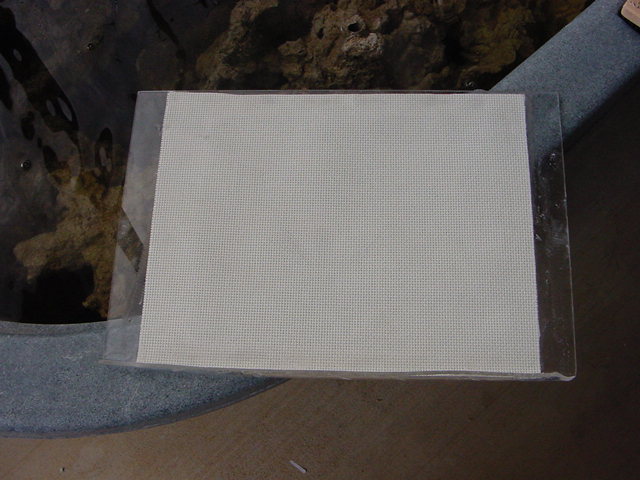
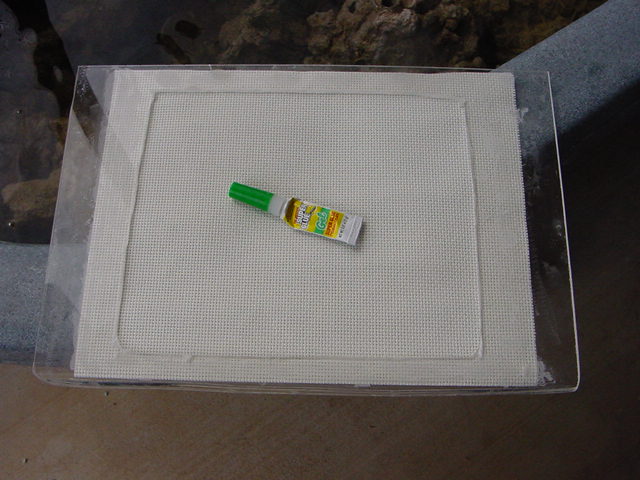
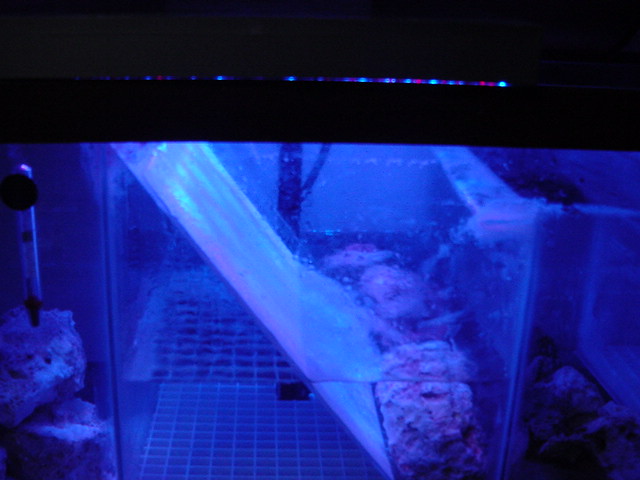
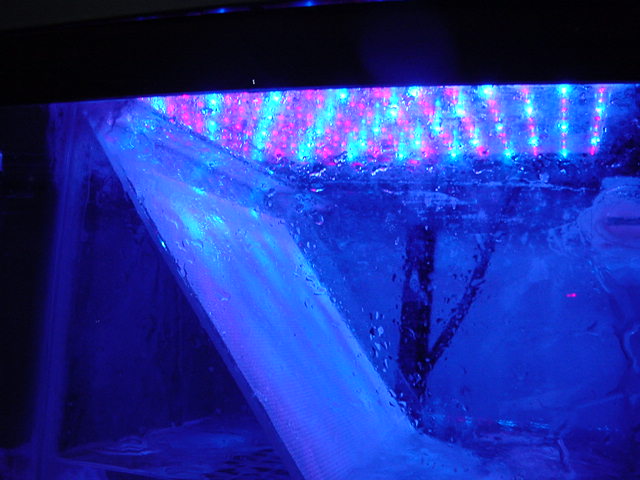
He knows that the part of the screen underwater will not contribute, so he made sure the part above the water had enough size to handle things. We'll see how LED's work!
.
.
.
any update on the led setup?
http:///forum/post/2781367
Well I'm trying to get caught up with the posts; gonna have to combine a few here to get them out without postponing anymore. Seems to be a lot of interest in scrubbers that are unique, like the giant one, and the solar one. Well today is another unique one, but first here are some results feedback:
"Pong" on the RF site said "i had a lot of green hair algae growing on my screen. noticed that the red algae in my DT has lessened dramatically."
"Johnt" on the UR site said "I've always used phosphate remover. I've tried most makes but always ended back using Rowa. since running the scrubber I've stopped the phosphate reactor and despite the scrubber not yet being at the Turf Algae stage the phosphate readings are dropping."
And now for the first screen on any thread to use LEDs! "Snailrider" on the AC site built it:




He knows that the part of the screen underwater will not contribute, so he made sure the part above the water had enough size to handle things. We'll see how LED's work!
.
.
.
any update on the led setup?
santamonica
Member
Is anyone here running the flat instead of vertical screen? I am curious about how these are coming along.
Basically, no. A few people wanted to, but I never heard back from them.
any update on the led setup?
Yes, he' got "some" growth, but not enough. And it was in "spots". He's current on the algaescrubber site, testing some more powerful LED's.
Basically, no. A few people wanted to, but I never heard back from them.
any update on the led setup?
Yes, he' got "some" growth, but not enough. And it was in "spots". He's current on the algaescrubber site, testing some more powerful LED's.
santamonica
Member
Can you reduce the screen width?
santamonica
Member
Success of the Day:
"Mxett" on the MD site: "I installed a simple [scrubber] over my refugium. It uses an old plastic fruit juice container and a syphon [which makes a surge device] to dump 2 litres onto a white plastic chopping board which lays horizontally over the top of the refugium. A reflective CFL [bulb] is situated just 10cm above this board. The surge occurs every 30 seconds, lasting for 15 seconds. Growth on the [scrubber] has been excellent. Harvesting the algae is performed every 1 to 2 weeks per SM's instructions. [should be weekly ] N & P have never been detectable in my system, BUT I have always struggled with a very persistant nuisance red algae! It threatened to overtake my entire tank in the months before installing this [scrubber], which is only a modest size for my 800 litre cube. Anyway, after 3 months of using the [scrubber] I can confidently say I have little to none of this red algae left! My purple tange eats it and always has, but with less nutrients available to it, it has just withered away, and he just finishes it off. Overall a great success over a difficult pest. Thanks SM for providing the inspiration and idea to create, install and use such a cheap, easy and effective natural filter."
] N & P have never been detectable in my system, BUT I have always struggled with a very persistant nuisance red algae! It threatened to overtake my entire tank in the months before installing this [scrubber], which is only a modest size for my 800 litre cube. Anyway, after 3 months of using the [scrubber] I can confidently say I have little to none of this red algae left! My purple tange eats it and always has, but with less nutrients available to it, it has just withered away, and he just finishes it off. Overall a great success over a difficult pest. Thanks SM for providing the inspiration and idea to create, install and use such a cheap, easy and effective natural filter."
"Mxett" on the MD site: "I installed a simple [scrubber] over my refugium. It uses an old plastic fruit juice container and a syphon [which makes a surge device] to dump 2 litres onto a white plastic chopping board which lays horizontally over the top of the refugium. A reflective CFL [bulb] is situated just 10cm above this board. The surge occurs every 30 seconds, lasting for 15 seconds. Growth on the [scrubber] has been excellent. Harvesting the algae is performed every 1 to 2 weeks per SM's instructions. [should be weekly
santamonica
Member
Scrubber FAQ 2.0 is now up, on the scrubber site.
santamonica
Member
.
Today's Success of the Day, from OceanParks on the MFT site, had a good story to it. So here it is with his posts and the dates:
12/17: SantiMonica: I've also built and installed your screen. I am on day 5. I have the brown/green film and was wondering how long before you start to see a noticable drop in Nitrates? I have a 110 gal reef tank with fish and my Nitrates are at 20ppm. Thanks.
12/18: and what wattage bulb would you suggest (pc flood) would you recommend for better results?
1/5: Ok. So I read your thread and built a scrubber (a true hobbyist). I'm in the middle of week three and I've done 2 cleanings and one freshwater rinse. Nitrates began at 30ppm and are now down to 5ppm (with the help of a 40% water change) in this 110 gallon reef tank. I removed the skimmer and UV sterilizer to allow room for the scrubber. I will compose a more formal, descriptive posting in the near future on my setup - one that I hope you will use in your RESULTS postings. I am still trying to get a grip of this thread thing....it is my first one. Did you say that you were getting better results with a different light bulb. If so can you please specify? Thanks! Enjoy the pictures! What do ya think?
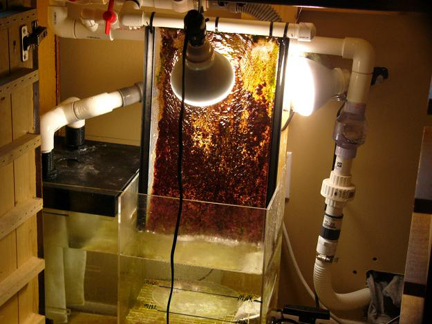
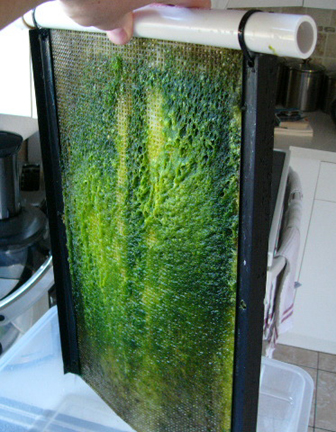
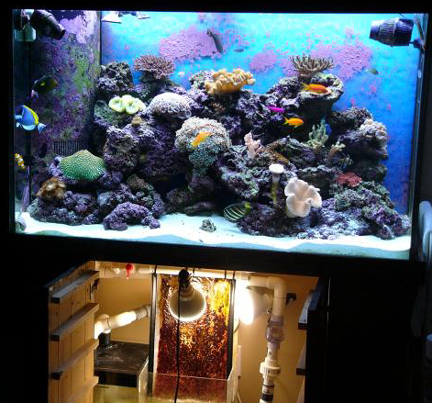
1/5: [Remove the filter socks.] Really about the socks? I'm afraid of too may particles floating around. I'll give it a try. Also, can I get the plant-grow bulb at Home Depot and is it in Flood form? I have the timer set for 16hrs on and 8hrs off, however, I get excited and want to turn them on early for (in my mind) faster results. Probably no better results? Ok. Off with the socks. Good idea. Is the grow-light a flood light like those pc flood light? Thanks for the help! I will send a full report and pictures in a few weeks!
1/7: I replaced my flood lights with 2700K "soft white" PC Flood lights today. Same wattage...they just seem dimmer. It's that red light. Hope it works better.
1/12: I spent some time reviewing the begining of this thread and noticed that most of the pictures showed bright green thick mats of algea on the screen. I am not getting that after 5 weeks. I am getting dark brown/red stuff and it's only about 1/4" combined. [The stealthy high-nutrient black/brown algae that must be removed right away.] I did use some of the brown/red stuff to seed the new screen when I built it. Should I rebuild the screen and seed it with some hair algae from the tank? [not now.] Also, at the bottom of my sump, beneath the screen there is red/brown slime forming (see picture). Should I remove/treat for this or can it be concidered benefitial? [leave it.]
1/12: Here is 5.1 oz of the black oil (I read from your other site). Funny enough, under the layer of black stuff there was some bright green algae. Any thoughts on that? [that's why it needs to be removed right away.]
1/20: CLEAR!!!!!! My scrubber has been up since December 18th and tonight the Nitrate test (Nutrafin) read clear indicating 0 nitrates! Awesome. Thank you SantiMonica. Awesome. 0 Nitrates on the Salifert Test too.
.
Today's Success of the Day, from OceanParks on the MFT site, had a good story to it. So here it is with his posts and the dates:
12/17: SantiMonica: I've also built and installed your screen. I am on day 5. I have the brown/green film and was wondering how long before you start to see a noticable drop in Nitrates? I have a 110 gal reef tank with fish and my Nitrates are at 20ppm. Thanks.
12/18: and what wattage bulb would you suggest (pc flood) would you recommend for better results?
1/5: Ok. So I read your thread and built a scrubber (a true hobbyist). I'm in the middle of week three and I've done 2 cleanings and one freshwater rinse. Nitrates began at 30ppm and are now down to 5ppm (with the help of a 40% water change) in this 110 gallon reef tank. I removed the skimmer and UV sterilizer to allow room for the scrubber. I will compose a more formal, descriptive posting in the near future on my setup - one that I hope you will use in your RESULTS postings. I am still trying to get a grip of this thread thing....it is my first one. Did you say that you were getting better results with a different light bulb. If so can you please specify? Thanks! Enjoy the pictures! What do ya think?



1/5: [Remove the filter socks.] Really about the socks? I'm afraid of too may particles floating around. I'll give it a try. Also, can I get the plant-grow bulb at Home Depot and is it in Flood form? I have the timer set for 16hrs on and 8hrs off, however, I get excited and want to turn them on early for (in my mind) faster results. Probably no better results? Ok. Off with the socks. Good idea. Is the grow-light a flood light like those pc flood light? Thanks for the help! I will send a full report and pictures in a few weeks!
1/7: I replaced my flood lights with 2700K "soft white" PC Flood lights today. Same wattage...they just seem dimmer. It's that red light. Hope it works better.
1/12: I spent some time reviewing the begining of this thread and noticed that most of the pictures showed bright green thick mats of algea on the screen. I am not getting that after 5 weeks. I am getting dark brown/red stuff and it's only about 1/4" combined. [The stealthy high-nutrient black/brown algae that must be removed right away.] I did use some of the brown/red stuff to seed the new screen when I built it. Should I rebuild the screen and seed it with some hair algae from the tank? [not now.] Also, at the bottom of my sump, beneath the screen there is red/brown slime forming (see picture). Should I remove/treat for this or can it be concidered benefitial? [leave it.]
1/12: Here is 5.1 oz of the black oil (I read from your other site). Funny enough, under the layer of black stuff there was some bright green algae. Any thoughts on that? [that's why it needs to be removed right away.]
1/20: CLEAR!!!!!! My scrubber has been up since December 18th and tonight the Nitrate test (Nutrafin) read clear indicating 0 nitrates! Awesome. Thank you SantiMonica. Awesome. 0 Nitrates on the Salifert Test too.
.
pcollins249
Member
WOW is all i can say after reading all of this! i bleached all of my LR b/c of algae. got tired of looking at it and scrubbing it. i bleached rock 7 months ago and now its slowly coming back. i have an old what i think is to be a dry sump. three chamber with bioballs but my return pump went out on me so i cant try this thing out yet
santamonica
Member
Well get it going so we can follow your story too 
santamonica
Member
One of the big benefits of a scrubber is that it keeps food in the water. Here is an update pertaining to this:
Part 1 of 7:
Taken from "Reef Food" by Eric Borneman:
http://www.***
"Detritus, marine snow, particulate organic material, and suspended particulate matter are all names for the bits of "dirt" [food] that flow around the reef; material that is composed of fecal material, borings, algae, plant material, mucus, associated bacteria, cyanobacteria and other particles. Decomposers (mainly bacteria and associated flora and fauna) break down waste material in the water, on the reef, and primarily, in the soft sediments. The result of their presence and action is not only a food source in and of itself, but provides raw material for channeling back into the food chain, largely through the benthic algae and phytoplankton.
"Phytoplankton [food] are small unicellular algae, or protists, that drift in the water column. They may be very abundant in and around coral reefs, and they are capable of absorbing large amounts of organic and inorganic nutrients. [...] Some of the reef animals can feed directly on phytoplankton; many soft corals, some sponges, almost all clams, feather-duster worms, and other filter feeders utilize phytoplankton directly as a food source. Small animals in the water column, termed zooplankton [food], also utilize phytoplankton as a food source. For the smaller zooplankton, phytoplankton and bacteria are the primary food source.
"Both of the [photos not shown] are from reefs on the Great Barrier Reef, Australia. The left photo shows the clear "nutrient poor" (oligotrophic) waters of the outer reefs. The right photo is of an inshore "nutrient rich" lagoon reef off Townsville. Notice how coral coverage in both systems is high, and even though the green phytoplankton-filled lagoonal reef is nutrient rich, it supports a high density of Acropora.
"Coral reef food sources, then, are largely produced by the ocean. Bacteria, detritus, phytoplankton, zooplankton, small benthic fauna, mucus, and dissolved organic and inorganic material of various types and sizes are what comprise the majority of food on a coral reef.
"In aquaria, we are faced with several realities. Our phytoplankton and zooplankton populations are generally negligible to non-existent in comparison with coral reef communities. Those which do exist are either rapidly consumed without having a chance to reproduce, or they are rapidly removed or killed by pumps and filtering devices or suspension-feeders. Coral mucus, bacteria, detritus, larval benthos and other "psuedo-plankton" might be present in a reasonable amount if the water column were not stripped. On the other hand, dissolved organic and inorganic material [nitrate, phosphate] levels are frequently much higher than they are in the ocean. [...] Even very well maintained aquaria are generally found with much higher levels of nitrogen and phosphorous than wild communities. Even though many desirable organisms are able to utilize these nutrients, levels in most aquaria are very unnatural, and coral reefs under such conditions often wane or die - a process known as eutrophication.
"It is the lack of water column-based food that results in limited success with the maintenance of some desirable animals, such as crinoids, flame scallops, clams, certain corals, sponges, bryozoans, and many other invertebrates. Even the symbiotic (zooxanthellate) corals [like SPS] suffer, despite many obvious long-term successes with these animals.
"In terms of previously mentioned export mechanisms, it really does little good to be cultivating or adding more food material in the water column if it is all being rapidly removed by filtration devices. Live rock and sand provide abundant filtration, and some of the articles in past issues describing the set-up and use of unskimmed tanks are, in my experience, something that should be seriously considered. Algae Turf Scrubbers are also viable systems that provide low ambient water nutrient levels [of nitrate and phosphate] while maintaining higher amounts of food and particulate matter in the water. I also feel that if protein skimmers are used, they should probably be used in an intermittent fashion.
Part 1 of 7:
Taken from "Reef Food" by Eric Borneman:
http://www.***
"Detritus, marine snow, particulate organic material, and suspended particulate matter are all names for the bits of "dirt" [food] that flow around the reef; material that is composed of fecal material, borings, algae, plant material, mucus, associated bacteria, cyanobacteria and other particles. Decomposers (mainly bacteria and associated flora and fauna) break down waste material in the water, on the reef, and primarily, in the soft sediments. The result of their presence and action is not only a food source in and of itself, but provides raw material for channeling back into the food chain, largely through the benthic algae and phytoplankton.
"Phytoplankton [food] are small unicellular algae, or protists, that drift in the water column. They may be very abundant in and around coral reefs, and they are capable of absorbing large amounts of organic and inorganic nutrients. [...] Some of the reef animals can feed directly on phytoplankton; many soft corals, some sponges, almost all clams, feather-duster worms, and other filter feeders utilize phytoplankton directly as a food source. Small animals in the water column, termed zooplankton [food], also utilize phytoplankton as a food source. For the smaller zooplankton, phytoplankton and bacteria are the primary food source.
"Both of the [photos not shown] are from reefs on the Great Barrier Reef, Australia. The left photo shows the clear "nutrient poor" (oligotrophic) waters of the outer reefs. The right photo is of an inshore "nutrient rich" lagoon reef off Townsville. Notice how coral coverage in both systems is high, and even though the green phytoplankton-filled lagoonal reef is nutrient rich, it supports a high density of Acropora.
"Coral reef food sources, then, are largely produced by the ocean. Bacteria, detritus, phytoplankton, zooplankton, small benthic fauna, mucus, and dissolved organic and inorganic material of various types and sizes are what comprise the majority of food on a coral reef.
"In aquaria, we are faced with several realities. Our phytoplankton and zooplankton populations are generally negligible to non-existent in comparison with coral reef communities. Those which do exist are either rapidly consumed without having a chance to reproduce, or they are rapidly removed or killed by pumps and filtering devices or suspension-feeders. Coral mucus, bacteria, detritus, larval benthos and other "psuedo-plankton" might be present in a reasonable amount if the water column were not stripped. On the other hand, dissolved organic and inorganic material [nitrate, phosphate] levels are frequently much higher than they are in the ocean. [...] Even very well maintained aquaria are generally found with much higher levels of nitrogen and phosphorous than wild communities. Even though many desirable organisms are able to utilize these nutrients, levels in most aquaria are very unnatural, and coral reefs under such conditions often wane or die - a process known as eutrophication.
"It is the lack of water column-based food that results in limited success with the maintenance of some desirable animals, such as crinoids, flame scallops, clams, certain corals, sponges, bryozoans, and many other invertebrates. Even the symbiotic (zooxanthellate) corals [like SPS] suffer, despite many obvious long-term successes with these animals.
"In terms of previously mentioned export mechanisms, it really does little good to be cultivating or adding more food material in the water column if it is all being rapidly removed by filtration devices. Live rock and sand provide abundant filtration, and some of the articles in past issues describing the set-up and use of unskimmed tanks are, in my experience, something that should be seriously considered. Algae Turf Scrubbers are also viable systems that provide low ambient water nutrient levels [of nitrate and phosphate] while maintaining higher amounts of food and particulate matter in the water. I also feel that if protein skimmers are used, they should probably be used in an intermittent fashion.

